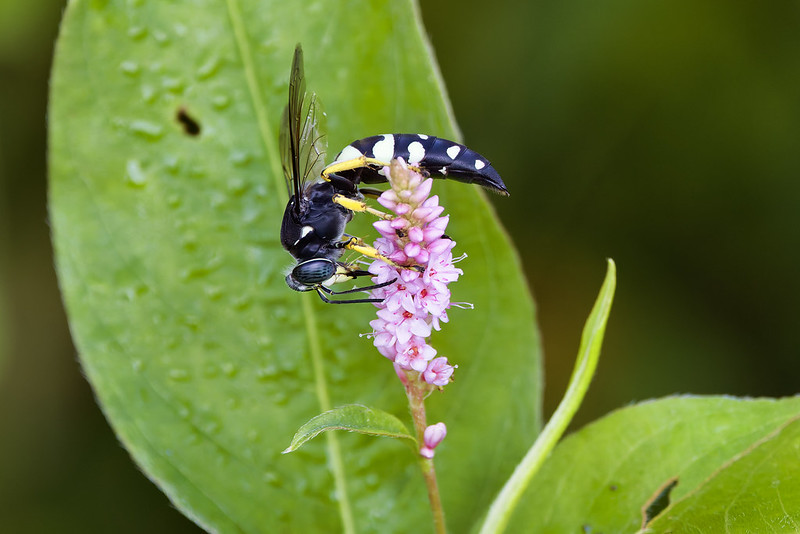The Horse Guard Wasp (Stictia carolina) is more than just a striking insect with black-and-pale markings. Photographed here on a pink water smartweed bloom at Sequoyah National Wildlife Refuge in Oklahoma, this species provides a vital service to livestock and wildlife alike: reducing the number of biting horse flies. From horses in pastures to deer in wetlands, many animals benefit from its presence.

Appearance of the Horse Guard Wasp
Large, fast, and boldly patterned, the Horse Guard Wasp is often mistaken for a hornet. Its black body is decorated with pale yellow spots, and its rapid flight gives it a fierce look. While the sight of a wasp circling a horse or cow can alarm onlookers, these insects are not aggressive toward humans or livestock. Instead, they are hunting for horse flies.
Habitat and Range
This sand wasp thrives in areas with loose, sandy soils where it can dig nesting burrows. Its range stretches from Pennsylvania south through Florida and west into the southern Great Plains, including Oklahoma and Arkansas. They are particularly common near pastures, ranches, and open grasslands where horse flies are abundant.
At places like Sequoyah National Wildlife Refuge, these wasps may also provide relief to native wildlife such as white-tailed deer, which are frequently pestered by biting flies during summer months.
Nesting and Life Cycle
Horse Guard Wasps are solitary nesters. Each female digs a burrow about 15 cm deep, creating a chamber for a single egg. She then provisions the chamber with paralyzed adult horse flies, often stocking between 30 and 60 flies. When the egg hatches, the larva has a ready supply of food.
Unlike social wasps that build communal nests, Horse Guard Wasps work alone. Despite this solitary lifestyle, their collective impact can be substantial, as multiple females nesting in one area can dramatically reduce fly numbers.
Ecological Role: More Than Pest Control
The most celebrated role of the Horse Guard Wasp is its appetite for horse flies, which improves the welfare of livestock such as cattle and horses. However, their impact extends further:
- Wildlife Relief: Deer, bison, and other large mammals benefit from lower fly populations. At refuges like Sequoyah, this can reduce stress for animals already facing habitat pressures.
- Pollination: While not as efficient as bees, Horse Guard Wasps also visit flowers for nectar, providing incidental pollination.
- Soil Health: Their burrowing helps aerate sandy soils, a small but beneficial contribution to the ecosystem.
Why Ranchers and Landowners Should Value Them
Horse flies are more than a nuisance. Their painful bites can cause stress, lower weight gain in cattle, and reduce the comfort of horses. By targeting adult flies, Horse Guard Wasps serve as a natural, chemical-free form of pest control. Welcoming these wasps means fewer horse flies, calmer animals, and reduced need for insecticides.
Misunderstood but Harmless
Fear of stings often leads people to misjudge the Horse Guard Wasp. In truth, they rarely sting unless directly handled. Their presence around livestock may seem alarming, but they are focused on hunting flies, not defending a nest. Recognizing this difference is key to appreciating their role as allies rather than threats.
A Photographer’s Perspective
Wildlife photographers have good reason to seek out Horse Guard Wasps. Their sharp patterns and fast movements make for exciting subjects, especially when captured on flowers or in flight. Photographing them in natural settings like Sequoyah National Wildlife Refuge not only highlights their beauty but also documents their ecological importance.
For close-up shots, look for them patrolling around horses, cattle, or deer-rich habitats during warm summer days. Patience pays off, as they often pause on wildflowers like water smartweed to feed on nectar.
Photo Details
Camera: Canon EOS R5 Mark 2
Lens: RF100-500mm F4.5-7.1 L IS USM
Aperture: ƒ/8.0
Exposure Compensation: 0
Shutter Speed: 1/640
ISO: 3200
Allies in Balance
The Horse Guard Wasp is a reminder that not every buzzing insect is a foe. By controlling horse flies, these wasps protect both domestic livestock and wild animals such as deer, while contributing to pollination and soil health. For ranchers, landowners, and wildlife managers, their presence signals a balanced ecosystem at work.
At Sequoyah National Wildlife Refuge and across the eastern United States, spotting a Horse Guard Wasp is witnessing nature’s pest control in action.

Steve,
You, and Mia, provide us with such richness of information through your images and your explanations of the world you photograph. …all are sources of joy for those of us who can’t get out there to see for ourselves.
Thanks so much.